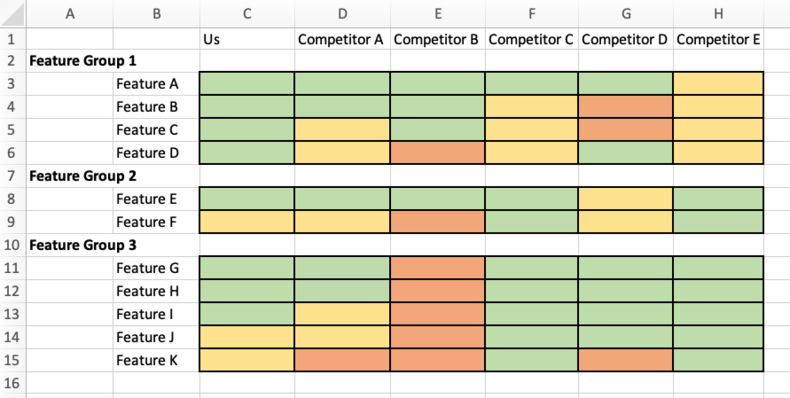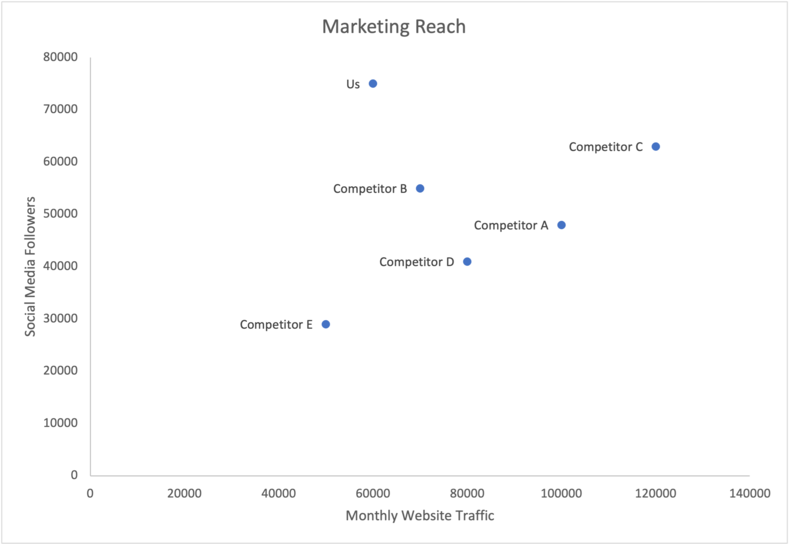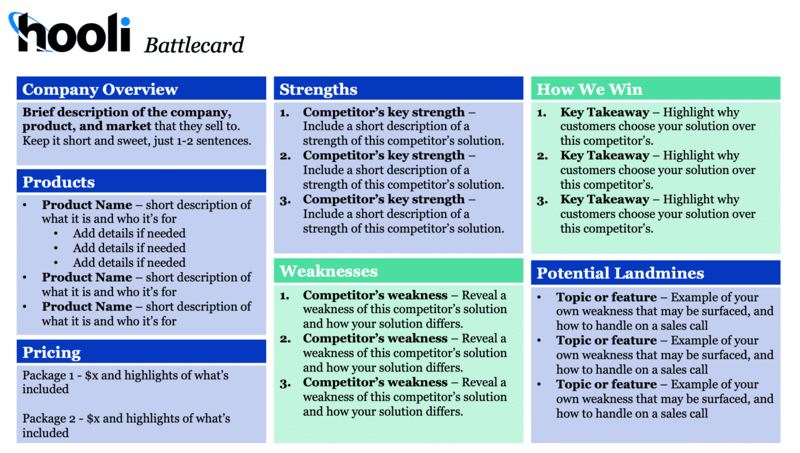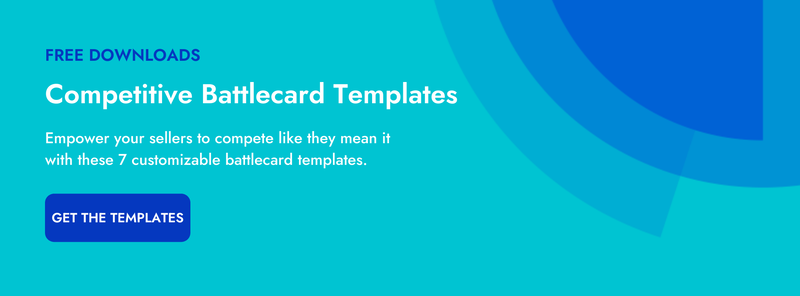I’m sitting at my desk as I write this intro—a desk that I assembled over the course of a snowy Saturday afternoon last winter.
Had the box in which the parts were shipped not included an instruction manual, my chances of successfully building this desk would’ve been close to zero. I would’ve given up after 10 minutes of halfhearted tinkering, shoved the parts into my closet, and laid down on the couch.
I can’t build stuff unless I’m given instructions. And if I were a seller, I wouldn’t be able to win competitive deals unless I were given tips, tactics, and talking points.
In other words, if I were a seller, I wouldn’t be able to win competitive deals unless I were given battlecards—which, as our title lays bare, are not the same as competitive comparisons.
Today, we’re going to:
- Define the meaning and purpose(s) of a competitive comparison
- Define the meaning and purpose of a battlecard
- Clarify the fundamental differences between these two assets
- Share three types of insights that you can pull from your competitive comparison into your battlecard
Let’s jump in!
What is a competitive comparison?
A competitive comparison is a framework for mapping and understanding the similarities and differences between your company and one or more alternatives. The classic example is one with which you’re likely familiar—the feature comparison matrix:

Of course, if you read our definition closely, it’s clear that a competitive comparison need not be product- or feature-focused. If you’d like—and if it’d be valuable to your fellow marketers—you can create a competitive comparison that looks at your industry through the lens of, say, website traffic and social media followers:

When it comes to competitive comparisons, what matters most is that you’re able to take datapoints—e.g., Competitor A doesn’t offer this feature, Competitor B drives this much traffic, etc.—and turn them into insights—e.g., This feature group is our greatest vulnerability, Our website traffic is relatively strong, etc.—that drive sound decision-making.
What is a battlecard?
A battlecard is a document that helps your sellers go head-to-head against a specific competitor. Because each battlecard is uniquely focused on a single competitor, its contents can vary. After all, the tips, tactics, and talking points your sellers need to beat Competitor X may not be the same as those that they need to beat Competitor Y.
That being said, there are certain categories of content that many of you will often find valuable: the competitor’s key strengths and weaknesses, reasons why you win and why you lose, landmines, and so on.

Download this battlecard template (+ 6 alternatives) >>
When it comes to battlecards, what matters most is that your sellers are able to quickly find the information they need and communicate it in ways that resonate with prospects. In other words, what matters most is that your sellers are neither:
- Helplessly scrambling for useful information, nor
- Peppering prospects with seemingly random facts that mean nothing to them
Fundamentally different—and closely related
There are two fundamental differences between competitive comparisons and battlecards:
- Whereas competitive comparisons can serve as both analysis tools and deliverables, battlecards are strictly deliverables.
- Whereas competitive comparisons, as deliverables, can be broadly valuable across multiple stakeholder groups, battlecards are created specifically for sellers.
If you’re skeptical about the utility of competitive comparisons as deliverables, think about your product team. When they’re tasked with establishing priorities for the upcoming quarter, a feature comparison matrix can ease the decision-making process considerably. (“We have an opportunity to be the first to market with XYZ, but that window is rapidly shrinking. We need to ship this before it’s too late.”)
Think about your fellow marketers, too. Something as simple as our example of the marketing reach matrix can be a valuable asset. (“We continue to lead the pack on social, but our website traffic is not where we need it to be. Let’s hold off on that Hootsuite upgrade and start searching for a Technical SEO Manager.”)
And here’s why competitive comparisons and battlecards, though fundamentally different, are closely related: Because competitive comparisons also serve as analysis tools, they can help you uncover the insights that are subsequently translated into the tips, tactics, and talking points on which your battlecards are built.
As an example, let’s say you’re a product marketer at Knock, a made-up software company that provides workplace communication tools. To empower your product team, you create a feature comparison matrix (which we’ll paste down here to keep you from scrolling back and forth):

Shifting focus to your sales team, you notice that, compared to Competitor E, you’re relatively strong on Feature Group 1 (written communication features) and relatively weak on Feature Group 3 (video communication features). To help your sellers stay cool, calm, and collected when conversations with prospects shift towards video, you could add a talking point like this to your Competitor E battlecard: “Zoom fatigue is rampant. Employees are on camera enough as it is, and our product team is laser-focused on the stuff that our customers actually want: tools that will help them effectively collaborate through the written word.”
Think of it this way: Your competitive comparison is a box of parts, and your battlecard is the instruction manual that empowers your sellers to put those parts together.
3 types of insights that you can pull from your competitive comparison into your battlecard
To cement this relationship between competitive comparisons (as analysis tools) and battlecards (as deliverables), let’s quickly explore three types of insights that you, as a PMM and an activator of competitive intelligence, can pull from the former into the latter:
- Warning signs. Sometimes, a seller will find out they’re in a competitive opportunity because their prospect explicitly says so. Other times, a seller will find out because their prospect asks a question that’s a little too specific—i.e., a question that was obviously planted by your competitor in order to put your seller on their heels. If one of your competitors offers a special feature or service that your product can’t match, that’s a good candidate for a warning sign.
- Talking points. Warning signs make for useful battlecard content because they alert your sellers to previously undetected competitors. But where do they go from there? As we showed with our Zoom fatigue example, talking points are designed to help your sellers pivot away from your weaknesses and towards your strengths.
- Landmines. Those questions that your competitors are planting in your prospects’ minds? They’re called landmines, and you should use them, too. If your product is strong in an area where one of its alternatives is weak, come up with clever questions for your sellers to ask their prospects (e.g., “How important is XYZ to your business?”).
Start activating intel today with free battlecard templates
Like we said earlier: Depending on which competitor you’re targeting, the optimal content for your battlecard may vary. That’s why we’ve created not one, not two, but seven free battlecard templates that you can download and put to use right now.
Your sellers will thank you. Click the banner below to get started!

Seeing is believing! Check out Crayon for yourself.
Take a Product TourRelated Blog Posts
Popular Posts
-
 The 8 Free Market Research Tools and Resources You Need to Know
The 8 Free Market Research Tools and Resources You Need to Know
-
 How to Create a Competitive Matrix (Step-by-Step Guide With Examples + Free Templates)
How to Create a Competitive Matrix (Step-by-Step Guide With Examples + Free Templates)
-
 6 Competitive Advantage Examples From the Real World
6 Competitive Advantage Examples From the Real World
-
 24 Questions to Consider for Your Next SWOT Analysis
24 Questions to Consider for Your Next SWOT Analysis
-
 How to Measure Product Launch Success: 12 KPIs You Should Be Tracking
How to Measure Product Launch Success: 12 KPIs You Should Be Tracking



